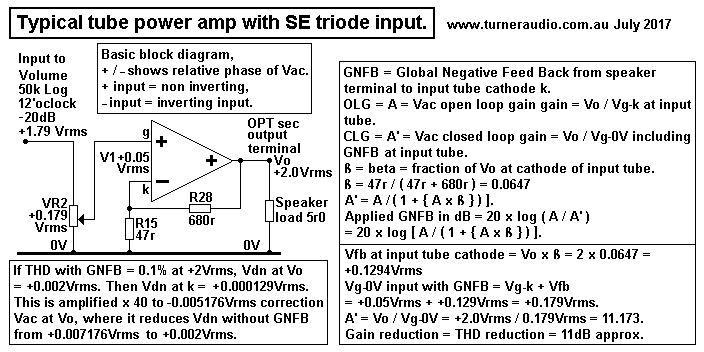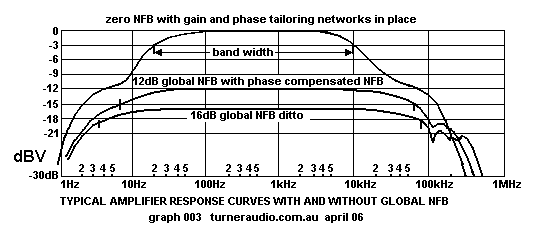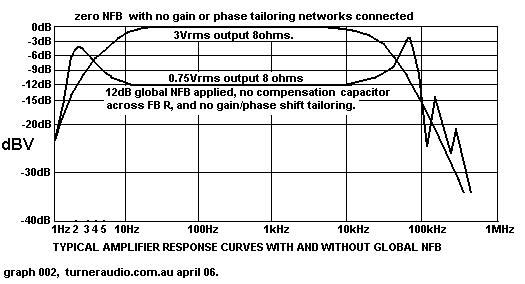| Tube
types, all class A |
SE Triodes | SE
Beam Tetrodes or Pentodes |
PP Triodes | PP
Beam Tetrodes or Pentodes |
| THD
max PO Zero NFB |
5%,
mainly 2H, minor 3H |
13%
variable 2H and 3H etc. |
2%
3H, other H low |
possible 2% many H |
| NFB
needed for THD% |
12dB
GNFB for 1.25% |
20dB
GNFB for 1.3% or use UL or CFB, then 10dB GNFB, maybe 0.4% |
12dB
GNFB, get 0.5% |
Need
20dB GNFB or use UL or CFB, then 10dB gnfb maybe 0.3% |
| Tubes
for 8W pure class A, for 96dB+ speakers. |
1
x 300B, 2 x 2A3, 1 x EL34T, 1 x 6550T,KT88T |
1
x EL34,6550,KT88,KT120 2 x EL84,6V6, SEUL, CFB. |
2
x300B,2A3,KT66T 4 x EL84T. |
2
x EL84, 6V6 UL or CFB |
| Tubes
for 16W pure class A, for 93dB+ speakers. |
2 x KT88T,6550T,KT90T 2 x 300B, 4 x 2A3, 1 x 845, 211 |
2
x EL34, KT66, 6550, KT88, KT90, KT120, SEUL, CFB |
2
x 300B, 4 x 2A3, 2 x 6550T,KT88T, KT90T, KT120T, |
2
x 6550,KT88,KT90,KT120 UL, CFB |
| Tubes
for 32W class A or AB, for 90dB+ speakers. |
4
x 300B,6550T,KT88T, KT90T,KT120T 2 x 845, 211 |
4
x EL34,KT66,6L6GC, 5881,6CA7,6550,KT88 SEUL, CFB |
2
x 300B,845,211 6550T,KT88T,KT90T KT120 |
2 x EL34,6L6GC,KT66 KT88,KT90,KT120 |
| Tubes for 48W+, class A or AB |
6 x
300B,6550T,KT88T, KT90T,KT120T 2 x 845, 211 |
4 x
6550,KT88,KT90, KT120,KT150 SEUL, CFB |
4 x 300B
6550T,KT88T,KT90T KT120 2 x 845,211 |
4 x
EL34,6L6GC,KT66 2 x KT88,KT90,KT120, KT150 |
| Expense per W. | Highest. | High
|
Low | Lowest |
| Sound
quality. |
Can be best. |
Worst unless CFB, UL + GNFB, then can be best. |
Can be best. | Fair
unless CFB, UL + GNFB, then can be best. |
| SPL
produced 2 speakers at 3M in average room |
Power
for SPL both amps. Speaker spec = 87dB/W/M |
Power
for SPL both amps. Speaker spec = 90dB/W/M |
Power
for SPL both amps. Speaker spec = 93dB/W/M |
| 108dB |
256W |
128W |
64W |
| <105dB |
128W |
64W |
32W |
| 102dB |
64W |
32W |
16W |
| 99dB |
32W |
16W
|
8W |
| 96dB |
16W |
8W | 4W |
| 93dB |
8W |
4W |
2W |
| 90dB |
4W |
2W |
1W |
| 87dB |
2W |
1W |
0.5W |
| 84dB |
1W |
0.5W | 0.25W |
| 81dB |
0.5 |
0.25W |
0.125W |
| 78dB |
0.25W |
0.125W |
0.062W |
| 75dB |
0.125W |
0.062W |
0.031W |


